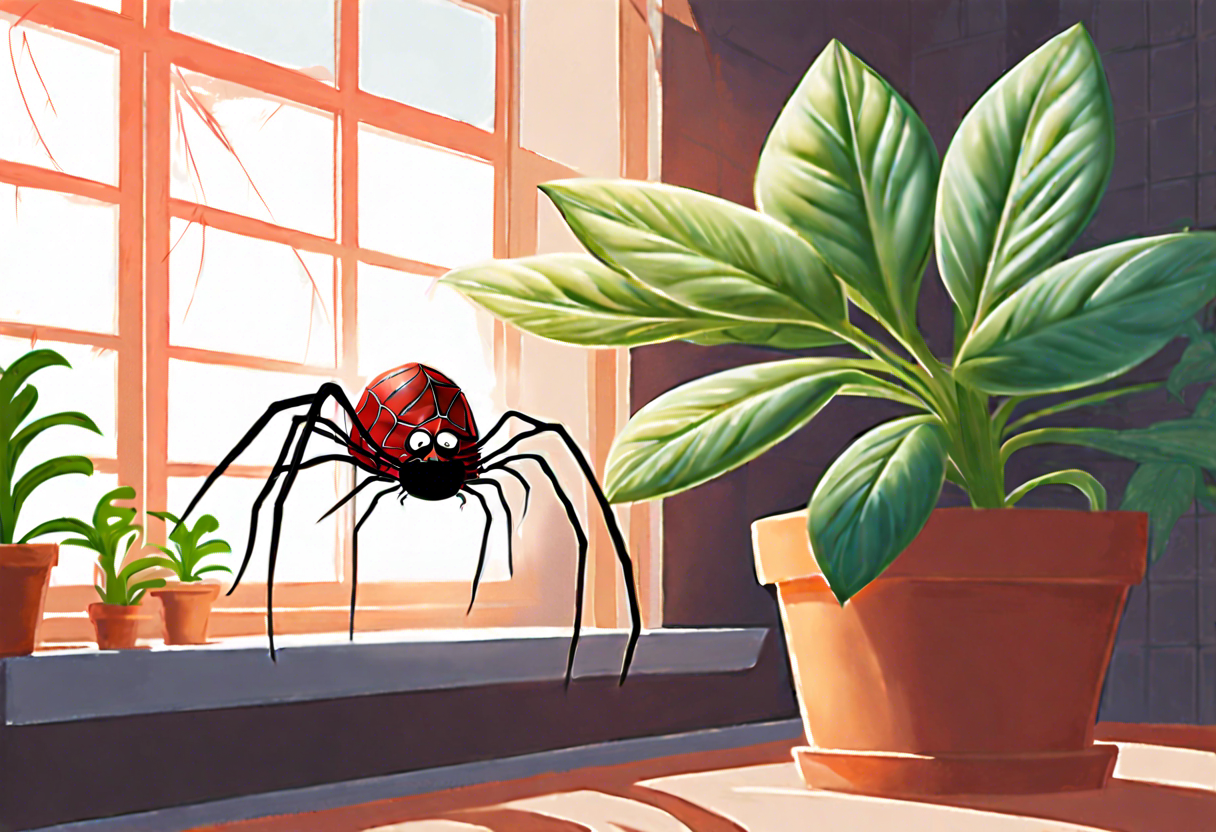Simple Ways to Identify Spider Mite Infestation on Indoor Plants
If you are an indoor plant enthusiast, you know how frustrating it can be to discover a spider mite infestation. These tiny pests, barely visible to the naked eye, can wreak havoc on your beloved plants if not identified and treated promptly. But fear not! By familiarizing yourself with the telltale signs of spider mite infestation, you can take action to protect your indoor plants and restore their health.
One of the first signs of a spider mite infestation is the presence of small, discolored spots on the leaves of your indoor plants. These spots may appear yellow or pale in color and can grow in size if left untreated. Additionally, you may notice fine webs or silk-like threads forming on the underside of the leaves. These webs are created by the spider mites and serve as their shelter.
Another way to identify spider mite infestation is to carefully examine the leaves using a magnifying glass. Spider mites are incredibly small, measuring only about 0.5 millimeters in size. They are usually reddish-brown or pale in color and have eight legs. Look for these tiny creatures crawling on the leaves or congregating near the leaf veins.
If you suspect a spider mite infestation but can’t find any evidence on the leaves, try tapping a leaf over a white piece of paper. This motion will dislodge any mites that may be present, making them more visible against the white background. Take note of their presence to confirm the infestation.
Additionally, spider mite infestations can cause visible damage to the plants themselves. Look for stunted growth, wilting leaves, or leaf drop. Spider mites feed on the plant sap, causing the leaves to become weak and damaged. If you notice these signs alongside the other symptoms mentioned previously, it is highly likely that your indoor plants are experiencing a spider mite infestation.
Now that you can identify the presence of spider mites on your indoor plants, it’s time to take action. In the next section, we will explore natural home remedies that can help combat these pesky pests and protect your plants.
Natural Home Remedies to Combat Spider Mites on Indoor Plants
Spider mites are tiny pests that can wreak havoc on your indoor plants if left unchecked. These minuscule arachnids thrive in warm and dry conditions, making indoor houseplants the perfect breeding ground for them. Fortunately, there are several natural home remedies you can try to effectively get rid of spider mites and protect your precious indoor plants.
One of the most effective ways to combat spider mites is by using water. Regularly misting your indoor plants with a fine spray of water helps increase humidity and creates an unfavorable environment for spider mites to thrive. Additionally, you can rinse the leaves of your plants under a gentle stream of lukewarm water to dislodge any pests and their eggs.
Another natural remedy is to create a mixture of dish soap and water. Dilute a few drops of mild dish soap in a spray bottle filled with water and thoroughly spray the affected plants, focusing on the undersides of the leaves where spider mites tend to hide. The soap helps break down their protective barriers and suffocates the pests, effectively eliminating them.
Neem oil is an organic insecticide that is highly effective against spider mites. It disrupts their feeding and reproductive cycles, eventually leading to their demise. Dilute neem oil according to the instructions on the packaging and spray it directly onto the affected plants. Be sure to cover both the tops and bottoms of the leaves for maximum effectiveness.
Peppermint oil is another natural remedy that can help get rid of spider mites. Mix a few drops of peppermint oil with water and spray it onto the affected plants. The strong aroma of peppermint acts as a natural deterrent for spider mites and can help prevent future infestations.
Predatory insects like ladybugs or lacewings into your indoor plant environment can also help control spider mites naturally. These beneficial insects feed on the pests and keep their population in check. You can purchase them from garden supply stores or online and release them onto your infested plants.
To prevent spider mites from returning, it’s important to regularly inspect your indoor plants for any signs of infestation. Check the undersides of leaves for webbing, stippling, yellowing, or wilting, as these are common symptoms of spider mite presence. isolating any infested plants can help prevent the spread of mites to other healthy plants.
The key to getting rid of spider mites on indoor plants is to create an inhospitable environment for them. By using natural remedies like water, dish soap, neem oil, peppermint oil, and predatory insects, you can effectively combat spider mites without resorting to harsh chemicals. Regular inspections and preventive measures are crucial in keeping your indoor plants mite-free and healthy. So, take proactive steps to protect your beloved plants from these pesky pests and enjoy a thriving indoor garden.
Effective Chemical Control Methods for Spider Mite Eradication
Spider mites can wreak havoc on indoor plants if left uncontrolled. These tiny pests feed on plant sap, causing leaves to turn yellow, wilt, and eventually fall off. While natural home remedies can be effective in combating spider mites, sometimes chemical control methods are necessary to completely eradicate these pests. Here are some effective chemical control methods to get rid of spider mites on indoor plants.
1. Acaricides: Acaricides are chemical agents specifically formulated to kill mites. They can be found in various forms such as sprays, dusts, or systemic treatments. Acaricides work by directly targeting and killing spider mites on contact. It is important to read and follow the instructions on the product label carefully to ensure safe and effective usage.
2. Miticides: Miticides are pesticides designed specifically for mite control. They are available in different formulations, including sprays and concentrates. Miticides work by interfering with the mites’ reproductive cycle, preventing them from laying eggs and multiplying. It is essential to choose a miticide that is labeled for use on indoor plants and to apply it according to the instructions provided.
3. Systemic Insecticides: Systemic insecticides are chemicals that are absorbed by the plant and are effective against a broad range of pests, including spider mites. These insecticides are applied to the soil or injected into the plant, allowing the plant to take up the chemical and distribute it throughout the tissues. As spider mites feed on the plant, they ingest the systemic insecticide, which ultimately kills them.
4. Horticultural Oils: Horticultural oils are highly refined petroleum-based products that suffocate spider mites and their eggs by coating them and blocking the supply of oxygen. These oils are safe to use on most indoor plants and can be applied as a spray. It is important to cover the entire plant surface, including the undersides of leaves, to ensure thorough coverage.
5. Spinosad: Spinosad is a naturally occurring insecticide derived from the fermentation of a soil bacterium. It is effective against a wide range of pests, including spider mites. Spinosad works by targeting the nervous system of the mites, causing paralysis and death. This insecticide is available in liquid or powder form and should be applied according to the instructions on the product label.
When using chemical control methods, it is important to follow safety precautions such as wearing protective clothing, gloves, and a mask. Ensure proper ventilation while applying chemical treatments and keep children and pets away from treated plants. It is also advisable to test the product on a small area of the plant before applying it to the entire plant to check for any adverse reactions.
While chemical control methods can be effective in eradicating spider mites, it is essential to address the underlying factors that may have caused the infestation. Regular inspection and maintenance, including maintaining proper humidity levels, providing adequate airflow, and frequently cleaning the leaves, can help prevent future infestations.
By incorporating these effective chemical control methods and implementing preventive measures, you can successfully eliminate spider mites from your indoor plants and ensure their continued health and vitality. Remember to always use chemical pesticides responsibly and as a last resort when natural remedies have proven ineffective.
Preventive Measures to Stop Spider Mites from Infesting Indoor Plants
Spider mites are tiny pests that can wreak havoc on your beloved indoor plants. As they feed on the plant’s sap, they cause leaves to turn yellow, wither, and eventually die. To ensure the health and vitality of your indoor plants, it’s crucial to take preventive measures to keep spider mites at bay.
-
Regularly inspect your plants: Regular inspection is key to identifying spider mite infestations early on. Check the undersides of leaves, as that’s where these pests tend to hide. Look out for small yellow or white spots, webbing, or speckles on the foliage.
-
Isolate new plants: Before introducing a new plant to your indoor garden, isolate it for a few weeks. This will help prevent any potential spider mites from spreading to your existing plants. Monitor the isolated plant closely during this period for any signs of infestation.
-
Maintain proper ventilation: Adequate airflow can discourage spider mites from infesting your plants. Make sure your indoor garden is well-ventilated by opening windows or using fans. This will also help in maintaining optimal humidity levels, as spider mites thrive in dry environments.
-
Avoid overwatering: Overwatering can create the perfect breeding ground for spider mites. These pests prefer dry conditions, so it’s important to strike a balance when watering your plants. Ensure that the soil is moist but not overly saturated, and avoid letting water accumulate in plant saucers.
-
Keep plants clean: Spider mites often find refuge in dusty environments. Wipe the leaves of your indoor plants regularly with a damp cloth to remove any dust buildup. This simple practice can help deter spider mites from settling on your plants.
-
Introduce natural predators: Consider incorporating natural predators of spider mites, such as ladybugs or predatory mites, into your indoor garden. These beneficial insects feed on spider mites and can help control their population.
-
Use preventive sprays: Organic insecticidal soaps or neem oil sprays can serve as preventive measures against spider mites. Apply these products to your indoor plants as directed, taking care to thoroughly coat the leaves and stems. This will create a barrier that deters spider mites from infesting your plants.
-
Quarantine infested plants: If you discover that one of your indoor plants is infested with spider mites, remove it from the proximity of healthy plants immediately. Quarantining the infested plant will prevent the mites from spreading to other plants, giving you a chance to treat it effectively.
By taking these preventive measures, you can significantly reduce the risk of spider mite infestation on your indoor plants. Consistency and vigilance are key, so make these practices a part of your regular plant care routine. Your indoor garden will thrive and remain mite-free, providing you with lush and healthy foliage to enjoy.
Importance of Regular Inspections and Maintenance to Keep Indoor Plants Mite-Free
Keeping indoor plants healthy and vibrant involves more than just regular watering and sunlight. One of the most common and persistent problems that plant owners face is spider mite infestation. These tiny arachnids can wreak havoc on plants, causing damage to leaves and inhibiting their growth. To ensure the longevity and vitality of your indoor plants, it is crucial to incorporate regular inspections and maintenance into your plant care routine.
Regular inspections are essential for early detection and identification of spider mites. These pests are minuscule, ranging in size from 0.2 to 0.5 millimeters, making them difficult to spot with the naked eye. However, with a keen eye and a magnifying glass, you can inspect the undersides of leaves, stems, and branches for signs of spider mites. Look for tiny specks, called stippling, which are a common symptom of their feeding activity. Additionally, keep an eye out for fine webbing or silk threads that they produce, especially between leaves and along stems. Early detection allows for immediate action, preventing a minor infestation from escalating into a full-blown problem.
Regular maintenance is crucial to keep your indoor plants mite-free. Start by isolating any infested plants to prevent the mites from spreading to neighboring plants. Trim and discard heavily infested leaves or branches to eliminate the majority of spider mites present. Once you have removed the visibly affected areas, consider employing organic or chemical control methods to eradicate the remaining mites.
Proper watering and fertilization practices is also crucial for preventing spider mite infestation. Overwatering can create a suitable environment for these pests, as it promotes fungal growth, which is their primary food source. Ensure that your plants are receiving adequate water, allowing the soil to dry slightly between watering sessions. Similarly, maintaining a balanced fertilizer regimen will keep your plants healthy and less susceptible to mite infestations.
In addition to regular inspections and maintenance, there are preventive measures you can take to reduce the risk of spider mites infesting your indoor plants. One effective method is to increase air circulation around your plants. Spider mites thrive in humid conditions, so providing proper ventilation can help deter their growth. You can achieve this by using a fan to circulate air or by periodically opening windows to allow fresh air to flow through the room.
Furthermore, regularly cleaning your plants’ foliage will remove dust and debris, which can attract spider mites. Wiping leaves with a damp cloth or gently rinsing them under lukewarm water can help keep these pests at bay. Additionally, avoid overcrowding your plants, as it can create ideal conditions for spider mite infestations. Give each plant enough space to grow and thrive, ensuring proper airflow between them.
Regular inspections and maintenance are vital for preventing and controlling spider mite infestations on indoor plants. By incorporating these practices into your plant care routine, you can keep your plants healthy, vibrant, and free from these troublesome pests. Remember to act promptly at the first signs of an infestation to avoid further damage and to maintain the overall health and aesthetics of your indoor plant collection.
Conclusion
To keep your indoor plants healthy and free from spider mite infestations, it is important to be able to identify the signs of these pests. Look out for tiny, moving dots on the leaves or the characteristic webbing that spider mites produce. Once you have confirmed an infestation, there are several natural remedies you can try. These include regularly washing your plants with a gentle, soapy solution, using neem oil or a mixture of water and rubbing alcohol to wipe down affected leaves. These methods can help suffocate and deter spider mites without harming your plants or the environment.
In some cases, chemical control methods may be necessary to completely eradicate spider mites. Acaricides specifically formulated for spider mites are available and should be used according to the manufacturer’s instructions. It is important to note that these chemicals can be harmful to beneficial insects and may require repeated applications for effective control. Therefore, it is crucial to consider the severity of the infestation and the potential risks before resorting to chemical control.
Prevention plays a significant role in keeping spider mites away from your indoor plants. Regularly inspect newly acquired plants before bringing them indoors, as spider mites can easily hitch a ride on them. Quarantining new plants for a few weeks can help ensure that they are free from pests before introducing them to your existing indoor garden. Additionally, providing proper care and conditions for your plants, such as adequate watering and fertilization, can strengthen their natural defenses against pests.
To maintain a mite-free environment for your indoor plants, it is essential to conduct regular inspections. Look out for any signs of spider mite activity, even if you have not had an infestation before. Catching an infestation early greatly improves the chances of successful eradication. Regularly remove any dead leaves or debris from the plant’s vicinity, as these can provide an ideal breeding ground for spider mites and other pests.
Periodic maintenance is another key aspect of keeping indoor plants mite-free. Regularly clean the leaves of your plants with a gentle spray of water to remove any dust particles that may attract spider mites. Additionally, avoid overcrowding your plants and maintain proper spacing to promote good air circulation, as spider mites thrive in hot and dry environments.
By being able to identify spider mite infestations, using natural remedies, considering chemical control methods when necessary, taking preventive measures, and regularly inspecting and maintaining your indoor plants, you can effectively combat and prevent spider mite infestations. With proper care and attention, you can ensure that your indoor plants remain healthy and vibrant, enhancing the beauty of your home while keeping these troublesome pests at bay.


